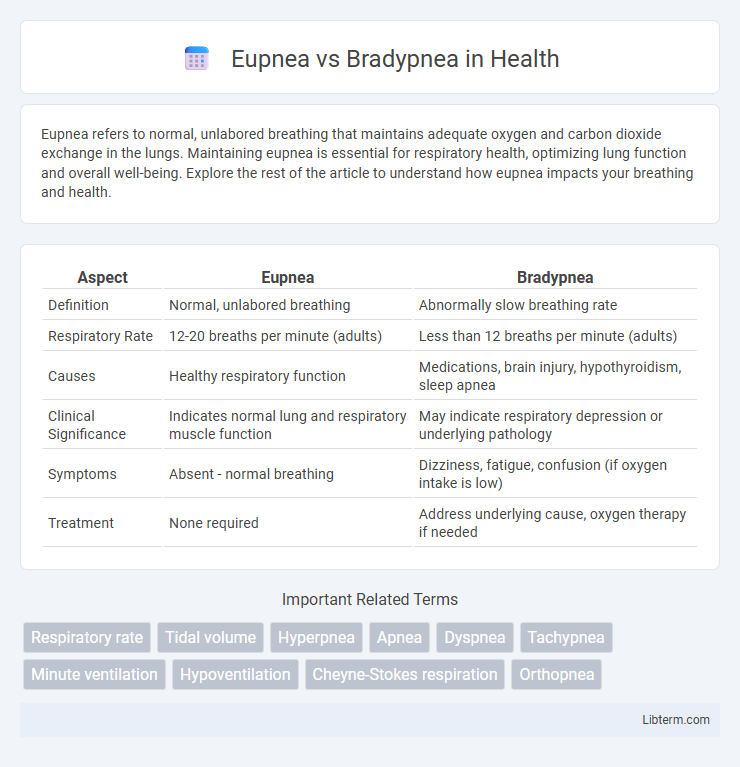Eupnea refers to normal, unlabored breathing that maintains adequate oxygen and carbon dioxide exchange in the lungs. Maintaining eupnea is essential for respiratory health, optimizing lung function and overall well-being. Explore the rest of the article to understand how eupnea impacts your breathing and health.
Table of Comparison
| Aspect | Eupnea | Bradypnea |
|---|---|---|
| Definition | Normal, unlabored breathing | Abnormally slow breathing rate |
| Respiratory Rate | 12-20 breaths per minute (adults) | Less than 12 breaths per minute (adults) |
| Causes | Healthy respiratory function | Medications, brain injury, hypothyroidism, sleep apnea |
| Clinical Significance | Indicates normal lung and respiratory muscle function | May indicate respiratory depression or underlying pathology |
| Symptoms | Absent - normal breathing | Dizziness, fatigue, confusion (if oxygen intake is low) |
| Treatment | None required | Address underlying cause, oxygen therapy if needed |
Introduction to Eupnea and Bradypnea
Eupnea refers to normal, unlabored breathing characterized by a regular respiratory rate of 12 to 20 breaths per minute in adults, ensuring efficient gas exchange and oxygen delivery to tissues. Bradypnea is defined by an abnormally slow respiratory rate, typically fewer than 12 breaths per minute in adults, which can result from neurological, metabolic, or drug-induced conditions leading to inadequate ventilation. Understanding the distinctions between eupnea and bradypnea is critical for assessing respiratory health and identifying underlying pathological states.
Defining Eupnea: Characteristics and Importance
Eupnea is defined as normal, unlabored breathing characterized by a regular rate of 12 to 20 breaths per minute in adults and a consistent tidal volume sufficient for effective gas exchange. It ensures proper oxygen delivery and carbon dioxide removal, maintaining homeostasis and optimal cellular function. Eupnea is crucial for sustaining metabolic processes and preventing respiratory complications associated with abnormal breathing patterns such as bradypnea, which is marked by an abnormally slow respiratory rate below 12 breaths per minute.
Understanding Bradypnea: Causes and Symptoms
Bradypnea is defined as abnormally slow breathing with a respiratory rate below 12 breaths per minute in adults, often caused by factors such as drug overdose, hypothyroidism, or brain injuries impacting the respiratory center. Symptoms of bradypnea include dizziness, fatigue, confusion, and in severe cases, hypoxia leading to cyanosis. Differentiating bradypnea from eupnea, which is normal, unlabored breathing at 12-20 breaths per minute, is crucial for timely diagnosis and treatment.
Key Differences Between Eupnea and Bradypnea
Eupnea refers to normal, unlabored breathing with a typical respiratory rate of 12-20 breaths per minute in healthy adults, while Bradypnea is characterized by an abnormally slow respiratory rate under 12 breaths per minute. Eupnea ensures efficient gas exchange necessary for cellular metabolism, whereas Bradypnea may lead to inadequate oxygen intake and elevated carbon dioxide levels, indicating underlying conditions such as hypothyroidism or neurological disorders. The key differences lie in respiratory rate, effort, and potential health implications associated with each breathing pattern.
Normal Respiratory Rates and Their Significance
Eupnea refers to normal, unlabored breathing with a respiratory rate typically between 12 and 20 breaths per minute in adults, indicating effective oxygen exchange and healthy lung function. Bradypnea is characterized by an abnormally slow respiratory rate, usually fewer than 12 breaths per minute in adults, which can signal respiratory depression, neurological disorders, or metabolic imbalances. Monitoring these respiratory rates is critical for assessing patient respiratory status and guiding clinical interventions to ensure adequate ventilation and oxygenation.
Common Causes of Bradypnea
Bradypnea, defined as abnormally slow breathing, often results from respiratory depression caused by opioid overdose, brain injury affecting the respiratory centers, or hypothyroidism. Conditions like obstructive sleep apnea and certain neuromuscular disorders can also contribute to decreased respiratory rates. Eupnea represents normal, unlabored respiration with a rate typically between 12 to 20 breaths per minute, distinguishing it from the slower rates observed in Bradypnea.
Health Implications of Eupnea vs Bradypnea
Eupnea, characterized by normal, unlabored breathing rates between 12-20 breaths per minute, indicates healthy respiratory function and adequate oxygen exchange, essential for maintaining homeostasis and organ function. Bradypnea, defined by a slower-than-normal breathing rate under 12 breaths per minute, may signal underlying health issues such as respiratory depression, brain injury, or metabolic disorders, potentially leading to hypoxia and compromised tissue oxygenation. Monitoring respiratory rates and patterns is critical for early detection of these conditions, guiding timely medical interventions to prevent serious complications.
Diagnostic Methods for Respiratory Patterns
Eupnea is characterized by normal, unlabored breathing with a respiratory rate typically between 12-20 breaths per minute, diagnosed through clinical observation and spirometry which measures lung function and airflow. Bradypnea involves abnormally slow breathing, often below 12 breaths per minute, and is assessed using pulse oximetry to monitor oxygen saturation and capnography to evaluate carbon dioxide levels in exhaled air. Polysomnography may be employed in complex cases to comprehensively analyze respiratory patterns during sleep, distinguishing between eupnea and bradypnea effectively.
Treatment Approaches for Bradypnea
Bradypnea, characterized by abnormally slow breathing rates below 12 breaths per minute, often requires treatment that targets the underlying causes such as metabolic disorders, central nervous system depression, or drug overdose. Common therapeutic approaches include administering supplemental oxygen, using medications like naloxone for opioid-induced respiratory depression, and, in severe cases, mechanical ventilation to support adequate respiration. Continuous monitoring of respiratory function and addressing potential reversible factors remain critical to ensure effective management and prevent complications associated with inadequate gas exchange.
Preventive Measures and Prognosis
Eupnea, characterized by normal, unlabored breathing, requires routine health maintenance such as regular exercise, balanced nutrition, and avoidance of respiratory irritants to sustain optimal lung function. Bradypnea, identified by abnormally slow respiratory rates, often signals underlying conditions like hypothyroidism or drug-induced respiratory depression, necessitating prompt medical evaluation and management to prevent complications. Prognosis for eupnea remains excellent with consistent preventive care, whereas bradypnea's outcome depends heavily on early identification and treatment of its root cause to avoid respiratory failure or hypoxia.
Eupnea Infographic

 libterm.com
libterm.com